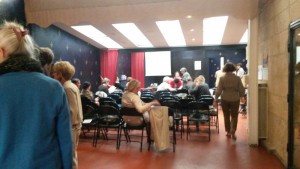"La Poule: Pratiques d'Élevage et Histoire Culturelle" or A French conference on chicken breeding practices and cultural history
As the month of May drew to an end, Ophélie Lebrasseur had the pleasure of attending “La Poule: Pratiques d’Élevage et Histoire Culturelle” (The chicken: Breeding Practices and Cultural History), a one-day conference organised by the Groupe d’Archéologie Médiévale (Centre de recherches historiques – EHESS) and held in honour of the exhibition “À table au Moyen Âge” at the Tour Jean-sans-Peur in Paris. The talks, held in a friendly and informal atmosphere, touched upon numerous topics from the role of the chicken in Antiquity and Medieval times to the establishment of modern breeds and the depiction of chickens in comic books and films.

The first part of the day was dedicated to the roles our feathered friends played in the past. Nicole Blanc opened the conference with her talk on chickens in Antiquity, touching upon the notions of pride, combative fervour and victory – three images which qualified chickens in Ancient Greece. Through the story of the Roman general Publius Claudius Pulcher, she explained the role the sacred caged chickens played in predicting the outcome of major battles, highlighting the importance of this animal in Roman times.
Perrine Mane followed on with an investigation of the phenotypes of Medieval chickens based on metrics and iconographies. She demonstrated that black or red/ginger chickens were most common while white chickens were exceptionally rare and condemned by the elite class. She finished her talk with an investigation of the Medieval henhouses and the various practices of Medieval poultry keeping, one of which involved elderly women keeping predators away with their distaff.
Historical documents were the medium used for the second half of the morning. Marie Anne Polo de Beaulieu first explored the various metaphors associated with chickens and hens through the ‘Recueils d’exempla’ and predications. Using numerous well defined case studies, she emphasized the high esteem attributed to this bird, particularly when associated to a Christian context. Mickaël Wilmart, on the other hand, focused on a single document: Prudent Le Choyselat’s ‘Discours oeconomique, non moins utile que recreatif, monstrant comme de cinqs cents livres, pour une foys employees l’on peult tirer par an quatre mil cinq cents livres de proffict honneste’. Written in 1569, the small treatise aimed to develop a new breeding practice that would allow for a major profit to be made. Mickaël Wilmart demonstrated the document was most likely written as a mean of entertainment but highlighted its value in terms of giving us a direct window on Medieval breeding practices.
The afternoon session was opened by Valérie Boudier and her analysis on the role of chickens within the paintings of the ‘Cinquecento’, investigating not only chickens, but also other types of poultry.
Frédéric Graber then followed with his talk on the industrialisation of the chicken during the 20th century, explaining the growth of the chicken industry from the end of the 19th century with the establishment of the broiler to the present day. From the ‘Palace Poultry Car’ in 1924, the ‘New York dressed’ in the 1940s to the development of the ‘chicken nugget’ in the 1980s, Frédéric Graber also touched upon the topics of the ‘industrial broiler’ and ‘Poultry Science’.
Bernard Denis explored traditional French chicken breeds, with a particular emphasis on the ‘Race de Bresse’, the French national breed reflected in its blue legs, white feathers and red comb. His talk provided a clear and well-researched summary of the history of chicken breeds and demonstrated the numerous crossings that had occurred in recent times between ‘traditional French breeds’ and the more exotic Asian breeds.
The day came to an end with the representation of chickens in comic books and films. Danièle Alexandre-Bidon scanned over 783 images from 498 comic books and gave a detailed analysis on the representation and roles of chickens in comics. Finally, Yohann Chanoir highlighted the fact that although chickens may appear to blend in the background when it comes to films, their roles are very well defined and carefully chosen by the director, as illustrated through a series of film extracts, making them the real stars of the show.
Needless to say that overall, this one-day conference was a pleasure to attend. Very well organised, the chicken was truly celebrated, not only through the numerous informative talks, but also through the attention to details, from chicken name-badges to the chicken-shaped cookies offered on chicken-themed napkins.

For further details on the conference: http://crh.ehess.fr/index.php?4523
For more information on the exhibition 'À table au Moyen-Âge', Tour Jean-sans-peur: http://www.tourjeansanspeur.com
Follow us
Keep up to date with the latest project news via our Twitter feed.
- — 5 years 8 months ago
- — 6 years 5 months ago
- — 6 years 6 months ago
- — 6 years 7 months ago

 ChickenCoop
ChickenCoop